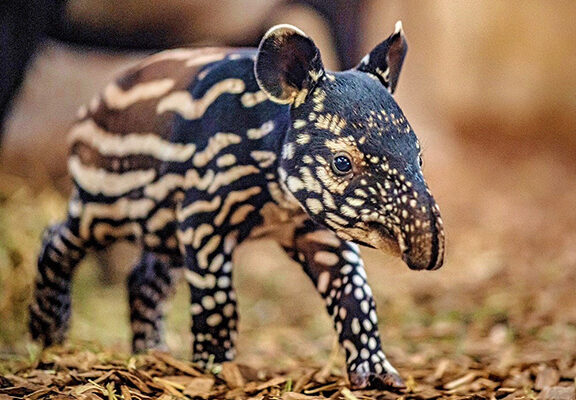- Home
- News
- What’s On
- Activities for Children
- Arts & Crafts
- Autos and Bikes
- Business events
- Car Boot & Auctions
- Charity events
- Churches & Religious
- Comedy
- Dance
- Days out & Local interest
- Education
- Exhibition
- Film
- Gardening & Horticulture
- Health
- Markets & Fairs
- Music
- Nature & Environment
- Spiritual
- Sport
- Talks and Discussions
- Theatre and Drama
- Business
- Local Information
- Jobs
- Deaths
- Charity events
- Contact Us
A baby tapir for Chester Zoo

A rare Malayan tapir has been born at Chester Zoo in what has been hailed as an “important moment” for the conservation of the endangered species.
The female calf, which has been named Nessa, arrived to parents Margery (10) and Betong (10) in the early hours of Wednesday 30 November, weighing just 9kg. It followed a 13-month-long (391-day) pregnancy.
Chester Zoo is one of just two British zoos currently caring for the Malayan tapir – a species listed as endangered on the International Union of Conservation of Nature’s (IUCN’s) Red List of Threatened Species.
Fewer than 2,500 are estimated to remain across Malaysia, Sumatra, Thailand and Myanmar, with hunting, illegal logging and mass deforestation blamed for a decline in numbers, which has seen more than half of the world’s Malayan tapirs lost in the last 40 years.
Mike Jordan, Director of Animal and Plants at Chester Zoo, said:
“We’re over the moon that Margery has delivered a healthy female calf – a birth that marks an important moment in our efforts to prevent the extinction of this wonderfully charismatic but sadly endangered species.
“The Malayan tapir is a species that’s under enormous pressure – its numbers have crashed over the course of the past four decades to frighteningly low levels, with hunting and habitat destruction being the main threats to its survival.
“Here at Chester Zoo we’re doing all we can to reverse that and carve out a brighter future for the species. Margery’s precious calf is a highly significant new arrival who will add valuable new genetics to the European endangered species breeding programme, which is working to ensure a safety net population of Malayan tapirs in conservation zoos like ours, guarding them from extinction. Meanwhile, we’re out on the ground in various parts of South East Asia where the species is found, working with our conservation partners and local communities to protect and restore its rainforest home.”
The Malayan tapir is the largest of the world’s four tapir species and is related to both the horse and the rhinoceros. It is an ‘odd-toed’ animal, having four toes on each front foot and three toes on each back foot.
At birth, baby tapirs have distinctive coats featuring a series of spots and stripes. This patterning is to help camouflage them on the forest floor, but slowly changes over the first six months of life to mirror the unique black and white pattern of their parents.
Rosie Owen, a zookeeper at Chester Zoo, added:
“It’s so lovely to once again hear the pitter-patter of tiny, spotty and stripy Malayan tapir feet. They’re really special animals, a highly endangered species and very few zoos in the whole of Britain care for them, so it’s fair to say that Nessa’s arrival has put huge smiles on all of our faces.
“Mum Margery is ever so good with her calf. Nessa is a real bundle of energy, confident and is often looking to explore but Marge is extremely attentive and always has a watchful eye on her. The pair of them doing really, really well together.”
Malayan tapir fact
· Malayan tapirs are found in Malaysia, Sumatra (Indonesia), Thailand and Myanmar
· The population of the species in the wild is estimated to have declined by more than 50% in the last 40 years, driven primarily by the wide-scale conversion of their habitat to unsustainable palm oil plantations and agricultural land. As a result, they are listed as an endangered species by the International Union for the Conservation of Nature (IUCN) and are also threatened by increased hunting for their fur, road-kills and trapping in snares left for other animals
· Chester Zoo is part of a European-wide conservation breeding programme for the endangered species
· Malayan tapirs typically give birth to one calf after a 11-13 months gestation period
· They have unusual, long flexible noses that they use to forage for food, and are known for their unusual courtship ritual which involves an assortment of wheezing and whistling sounds. They will then sniff each other, walking around in circles before mating
· Malayan tapirs also have poor eyesight, which makes them rely heavily on their excellent senses of smell and hearing

You must be logged in to post a comment Login